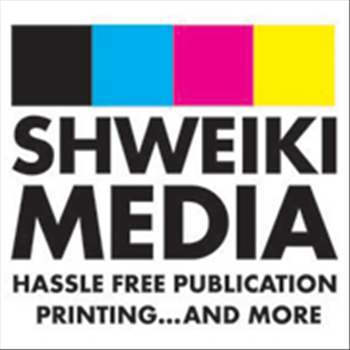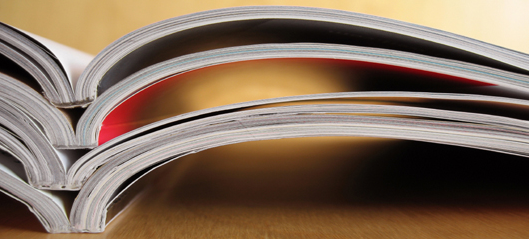Right Now
How Much Does It Cost To Print Magazines
Shweiki Media printing company specializes in hassle-free printing of magazines, post cards, fliers, brochures and more... For FREE print quotes and samples:...
1,000 magazines, 5,000 magazines, 10,000 magazines, etc…?” you would get
a quick answer, but unfortunately, it’s not that simple. There are many
costs associated with printing a magazine, and it’s important for
publishers to be familiar with the factors that affect these costs to
avoid being taken advantage of and ensure that they are securing the
best deal possible from their printer. Here David Reimherr, Vice
President of Sales for Shweiki, breaks down the factors that determine
printing costs in a must-watch webinar.
How much does printing cost?
What you need to know about your job to get an accurate estimate:
• Final Trim Size- The final size of your finished magazine after it is trimmed (i.e. 8 3/8 x 10 7/8):
This is not to be confused with the size of the files. It’s important
to note that dimensions are given in “width x height.” The easiest way
to remember this is by remembering that the height is the side where the
binding or spine is. So, when providing a dimension of 10 7/8 x 8 3/8,
this magazine would be bound on the 8 3/8 side and would look more like a
landscape than a portrait view.
• Page Count – The number of pages you will be sending including covers:
This shouldn’t be confused with the number of sheets of paper or the
number of spreads. Often, this can be a source of confusion and will
lead to miscommunication. If the publisher is talking in sheets while
the estimator is talking in pages, the publisher is going to end up
thinking they got an incredible price…until the files come in! It’s
crucial to count each page: cover is page one, inside cover is page two,
etc., until the back cover, which is the last page. One other way that
page count can be communicated is by giving a “+ cover” count, meaning
that one provides the total number of inside pages + the four-page cover
(front cover, inside front cover, inside back cover, back cover). But
for the sake of clarity, it’s always best to say 64+4 or 68 total pages,
etc.
• Paper – The weight, grade, and stock of the paper which your project will be printed on:
Paper Weight - Magazines can be printed on
either the same type of paper on the inside pages and the cover (a style
that is referred to as “self cover”) or a thicker paper on the cover
pages and a thinner paper on inside pages (often referred to as the body
or guts). There are many different paper weights and stocks to choose,
and here they are listed from the thinnest paper stocks to the thickest…
- 38 lb text
- 40 lb text
- 45 lb text
- 50 lb text
- 60 lb text
- 70 lb text
- 80 lb text
- 100 lb text
- 60 lb cover (same as 6 pt cover)
- 70 lb cover (same as 7 pt cover)
- 80 lb cover (same as 8 pt cover)
- 100 lb cover (same as 10 pt cover)
- 120 lb cover (same as 12 pt cover)
- 140 lb cover (same as 14 pt cover).
Paper Grade – Paper is graded on a scale of
one to five, with one being the whitest of the whites, and five being a
lower quality paper that typically has a yellow-ish tint. Grade four or
five paper is often described as groundwood. Standard magazine-grade
paper is normally a number-three grade. However, occasionally a lower
grade paper, like a number four or number five, might work for inside
pages.
Paper Stock – There are 3 main paper types to choose from:
Gloss - The majority of magazines today are
printed on gloss paper. Gloss papers are coated to give them a shiny or
lustrous appearance. Gloss papers are less opaque, have less bulk, and
are less expensive than dull or matte papers. One should use gloss paper
if they want their colors to “pop.”
Dull - Smooth surface paper that is low in gloss. Dull coated paper falls between matte and glossy paper.
Matte - A non-glossy, flat-looking paper.
Matte papers are normally a bit higher in cost and are the perfect way
to give a publication an elegant feel.
• Quantity – The number of printed copies needed:
Whether it’s 100 or 500 or 1,000 or 5,000 etc., it’s important for
one to let their printer know what they want. It is normal for printers
to allow anywhere from a 3%-5%-10% overage/underage. (You can read more
about that here.) Some
printers charge for overs that one might not ask for nor want, so it’s
important to be very clear when getting bids and ask about any overage
policies up front.
• Binding Style - The format in which your magazine will be bound:
There are a few different types of binding, and the two most common are perfect-bound and saddle-bound.
Perfect-bound:
This is the square-edge look seen with some of the magazines on
newsstands with larger page counts. There is not really a maximum number
of pages that one can perfect bind, but there is normally a minimum
amount of pages required to perfect bind. One should ask their printer
for specific minimum requirements.
Saddle-bound (or saddle-stitching):
This is the binding process that uses staples. Normally, saddle
stitching is a bit more cost-effective when compared to perfect
binding. There is no minimum page count required, but there normally is
a maximum. Again, one should simply ask their printer what their limits
are.
Spiral binding:
This is the also referred to as coil binding, and it is the binding
normally used for cookbooks, notebooks, or any other publication with
pages that need to open up completely and lay flat to be the most useful
to the reader. Spiral binding is usually much more expensive than
saddle or perfect binding, but it certainly has its place.
Case binding:
This is the most common type of binding used for hardbound books,
like textbooks or novels. In the case binding process, pages are sewn
together, hard covers are attached, and then covered with cloth, vinyl
or leather cases.
• Coatings : The type of coating you want for your magazine:
The most common coatings for magazine covers are gloss UV, matte UV and Varnish.
Gloss UV –This is the extra shiny coating
that adds a sheen to the printed product. Gloss UV will enhance colors
and preserve the paper from fading, yellowing or tearing.
Matte UV – This coating gives the cover a more textured, smoother feel.
Varnish – The best way to describe varnish is a less glossy, less shiny Gloss UV.
• Shipping : The exact address of where everything needs to be shipped:
It is best to let the printer know exactly where everything ships, as
well as the details of the shipment. (Is it going to a residential
neighborhood? Is the shipment going somewhere that does not have a dock
and will need a lift gate?) Also, it’s important to let the printer
whether the magazines should be shipped in boxes or straps. Some
printers charge for boxes, so it’s important to ask when getting a
quote.
Helpful hints when getting magazine pricing:
* For self covers (magazines with the same paper used throughout the
whole thing), page counts that will get the best pricing will usually be
in multiples of 16 (16, 32, 48, 64 etc.). So, if one is asking for
pricing on a self cover magazine at 12 or 28 or 44 pages and the printer
does not suggest a 16, 32 or 48-page option, one should hang up the
phone immediately!
* One should always get samples ahead of time. Some paper stocks are
similar enough in feel that it will be worth it to get the lesser grade
to save on costs. For instance, 45-lb. paper can often replace a 50 lb,
60-lb. paper can often replace 70 lb., and 8-pt. papers can often
replace 10-pt., without the average person being able to tell much of a
difference in feel. However, 50 lb. paper may feel much thinner than 60
lb. The best strategy is to get samples and actually feel them.
*People really do judge a book by its cover, and the same rings true
with magazines. Often it’s a good idea to acknowledge the importance of
first impressions and invest in the cover, rather than the inside pages.
* If you are not dead-set on your final size, look at other options
that can save you money. Some common sizes that can garner lower pricing
are 8 3/8 x 10 7/8, 6 x 9 and 5 3/8 x 8 3/8. If you want a different
look but still want to to have a full size publication, most printers
can print at a final size of 9 x 10 7/8, and it will cost close to what
you would pay for an 8 3/8 x 10 7/8 size.
*One should get multiple options from their printer to see if a
different look is worth the additional cost or additional savings. It’s
important not to assume anything and to know that what’s considered
“significantly cheaper” or “a lot more expensive” is often completely
relative, and will mean something different to everyone.
I hope that you’ve found this information helpful, and when you are
ready to look for pricing, feel free to contact me or visit our website
at shweiki.com. I’ll be happy to talk with you, answer any of your
questions and send you printed samples so you can consider all of your
options. We are a San Antonio Printer specializing in magazine printing but service clients from all corners of the country.
Click here for some particularly excellent magazine printing.
-
How Much Does It Cost to Print 1,000/5,000/10,000/20,000 Magazines, Catalogs or Calendars?
In a perfect world, if you were to ask"What does it cost to print 1,000 magazines, 5,000 magazines, 10,000 magazines, etc…?" you would get a quick answer, but unfortunately, it's not that simple. There are many costs associated with printing a magazine, and it’s important for publishers to be familiar with the factors that affect these costs ...
More Posts
Report This Post
Please complete the following requested information to flag this post and report abuse, or offensive content. Your report will be reviewed within 24 hours. We will take appropriate action as described in Findit terms of use.







